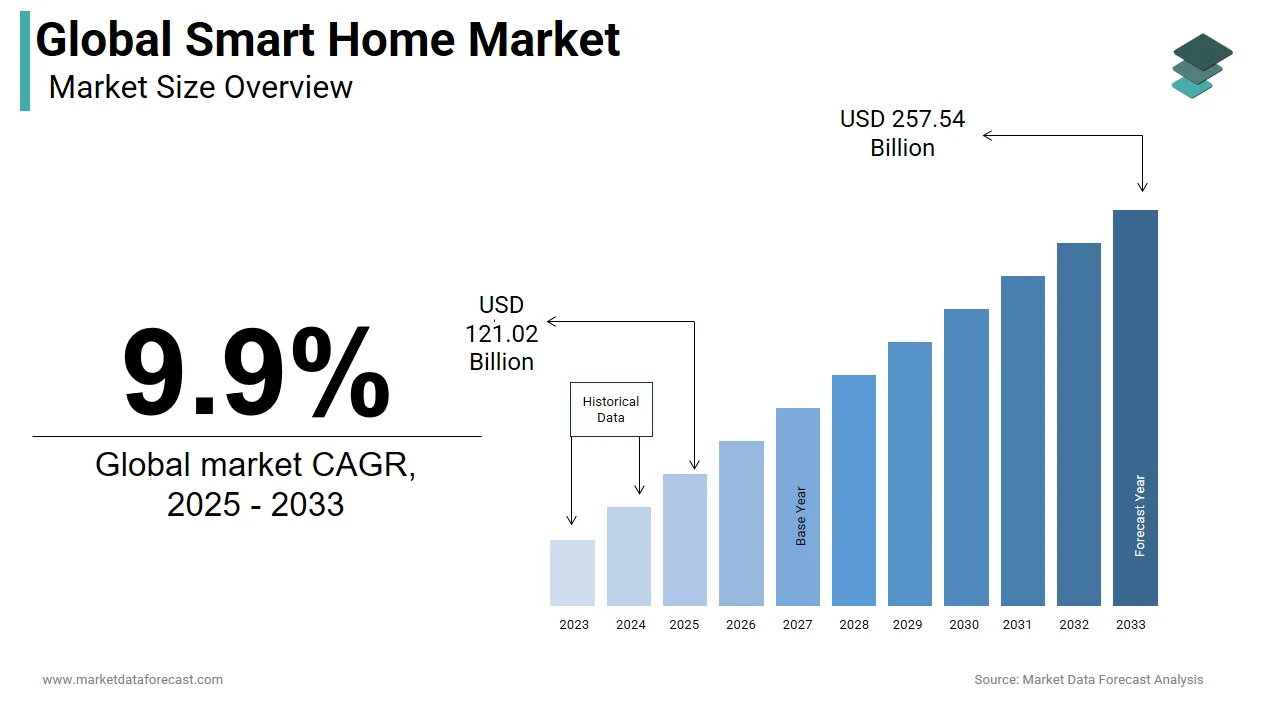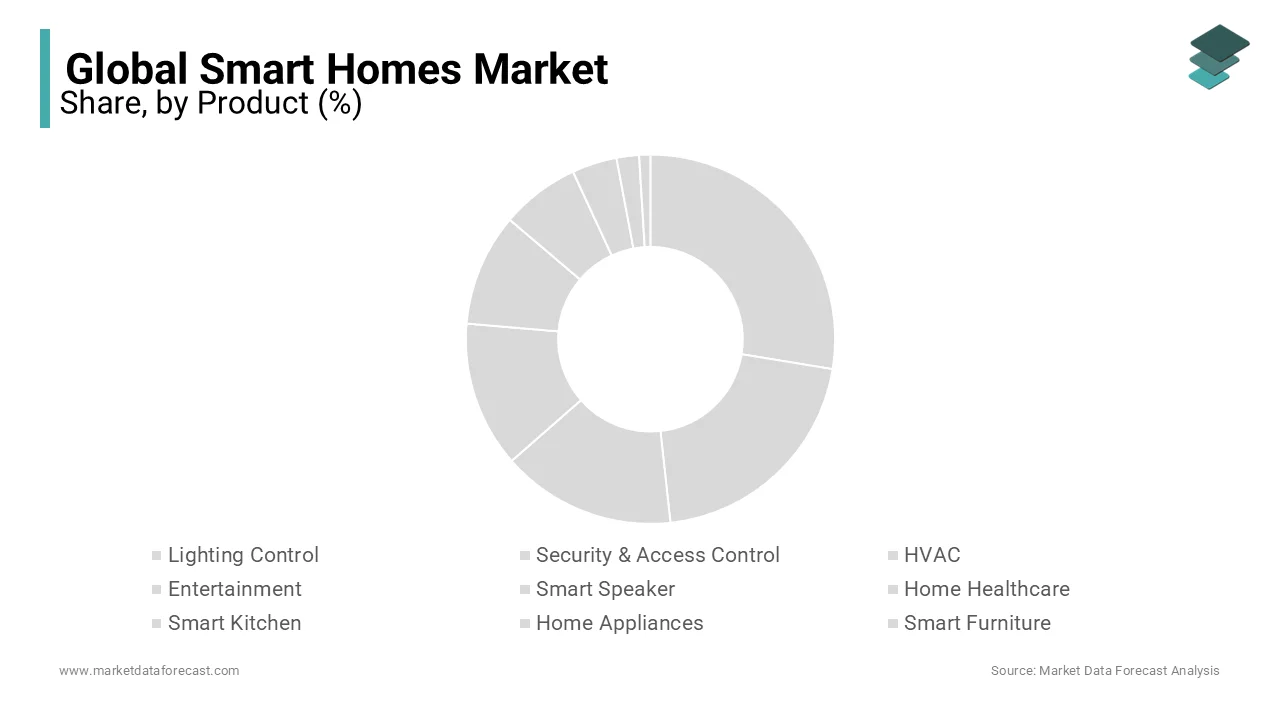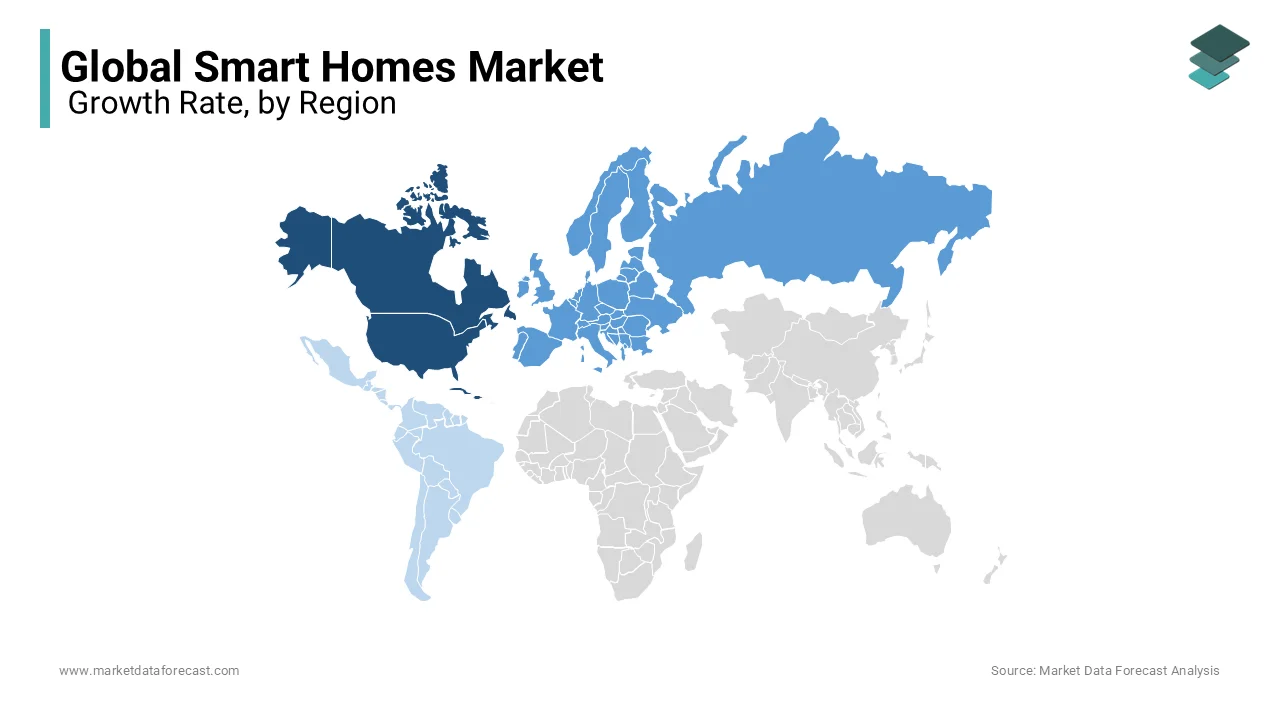Global Smart Home Market Size, Share, Trends, & Growth Forecast Report By Product (Lighting Control, Security & Access Control, HVAC, Entertainment, Smart Speaker, Home Healthcare, Smart Kitchen, Home Appliances, and Smart Furniture), Technology (Wireless Technology and Cellular Network Technology), & Region - Industry Forecast From 2025 to 2033
Global Smart Home Market Size
The global smart home market was worth USD 110.12 billion in 2024. The global market is predicted to reach USD 121.02 billion in 2025 and USD 257.54 billion by 2033, growing at a CAGR of 9.9% during the forecast period.

Smart homes are connected to the Internet of Things, smartphones, and tablets that allow owners to control various appliances like lights, thermostats, and other devices remotely. In urban cities, the demand for smart homes is very high to live a hassle-free life in their day-to-day hectic scheduled working hours. All the electronic appliances connected to the internet can be controlled or operated from anywhere, which makes a home run more efficiently. Smart homes are designed to work in a way that fits the house owner’s schedule. The major advantage of the adoption of the smart home is the effective utilization of energy. The lighting control system works with the sensor and can adjust the brightness. If there is no person in the home, the lights will be off and switch on automatically if a person enters. Rapid changes in the technology in the construction field are anticipated to introduce higher-end advanced systems in smart homes to increase security and save the usage of energy. According to recent reports, out of 140 million homes, 47.4 million homes are estimated to be smart homes in the US.
MARKET DRIVERS
Increasing disposable income, especially in developed and emerging countries, is another common factor that is driving the growth rate of the market.
In the world of modern era, people are more inclined to have safety and security at homes. Smart homes are designed to ensure high security through controlled locking system. The locking system can be controlled remotely that is mainly attributed in leveraging the growth rate of the market.
People in urban areas look for the most desirable and luxurious home properties that are intended to fuel the demand for smart homes. The easy availability of the Internet of Things in every corner of the world is also one of the major factors that will allow the smart home market to grow immensely. The term internet is most common everywhere. That is changing the lifestyle and livelihood. The rise in the number of smartphone users with an internet connection is anticipated to propel the growth rate of the market. Across the world, there will be 4.88 billion smartphone users in 2024, and the number of users will increase by 635 billion by 2023. The number of smartphone users has increased by 2.15x since 2020, which is a positive sign that the Smart Home Market will eventually grow.
MARKET RESTRAINTS
However, the high initial and maintenance costs of smart homes are restraining the growth rate of the market.
Common people cannot afford such highly advanced technologies due to their cost factor. In undeveloped countries, the demand for smart homes is even less due to the lack of flexibility in adopting the latest technology in the Internet of Things and connected devices. This factor is likely to degrade the size of the Smart Home Market. Also, a lack of awareness over the utilization of energy-saving devices in homes and reluctance to adopt advanced technologies due to poor internet access is also hampering the growth rate of the market.
MARKET OPPORTUNITIES
The Smart Home Market has substantial growth opportunities in the coming years. It is expected that the world will be strongly connected to the Internet of Things with the growing prominence of adopting the latest technological developments.
It is estimated that by the end of 2025, there will be more than 75.4 billion electronic gadgets that are connected to the internet, and these advancements may create scope for the growth of the market during the forecast period.
Another feasible factor that is leveling up the size of the Smart Home Market is the design to reduce energy costs. Smart homes are specifically designed to meet specific needs by automatically performing actions. It allows users to reduce energy costs by performing various actions related to smart energy management. Smart homes consume much less electricity than any other devices, which reduces the negative impact of environmental pollution. In today’s world, it is highly important to reduce energy consumption to improve energy security, which helps in reducing environmental pollution. The UK is the first country to adopt the most advanced technologies in constructing smart homes to meet the net zero emissions target by 2050. A plan to build energy-efficient homes and retrofit the existing ones in the UK is one of the stringent actions by the government to achieve their net zero emissions goal by 2050. 14% of total energy is consumed by 29 million homes only in the UK, which is a factor in noticing and adopting the new changes accordingly. It is calculated that a three-bedroom house releases 5 tonnes of carbon annually, which is a rising concern to reduce the harmful effects on the environment. The rising population eventually even elevates carbon emissions, which is why taking necessary actions at this time makes the world effective to live in. The UK is stepping forward in adopting all the necessary in the construction of homes to make completely zero carbon emissions, which can surge the share of the Smart Home Market.
MARKET CHALLENGES
Growing privacy and security concerns with the increasing number of cyber attacks on connected devices are major challenges for the Smart Home Market.
As smart homes are connected to the Internet of Things with either smartphones or tablets, it is very easy to hack personal data, which is a rising concern in adopting these changes. However, research studies are set to launch highly efficient solutions to protect from breachers, which are all set to promote the growth opportunities for the Smart Home Market in the foreseen years.
REPORT COVERAGE
|
REPORT METRIC |
DETAILS |
|
Market Size Available |
2024 to 2033 |
|
Base Year |
2024 |
|
Forecast Period |
2025 to 2033 |
|
CAGR |
9.9% |
|
Segments Covered |
By Product, Technology, and Region |
|
Various Analyses Covered |
Global, Regional & Country Level Analysis, Segment-Level Analysis, DROC, PESTLE Analysis, Porter’s Five Forces Analysis, Competitive Landscape, Analyst Overview on Investment Opportunities |
|
Regions Covered |
North America, Europe, APAC, Latin America, Middle East & Africa |
|
Market Leaders Profiled |
Amazon, Inc. (USA), Apple Inc. (USA), Google (USA), ADT (USA), Robert Bosch GmbH (Germany), ASSA ABLOY (Sweden) and ABB Ltd. (Switzerland), Ingersoll-Rand PLC (Ireland), ABB (Switzerland), Legrand SA (France), GE (United States), Comcast Corp. (USA), Hubbell Inc. (USA), Samsung Electronics Co., Ltd. (South Korea), LG Electronics (South Korea), Sony (Japan), Control4 Corp. (United States), Lutron Electronics Co. Inc. (United States), Vivint (United States) States) and Axis Communication AB (Sweden), and Others. |
SEGMENTAL ANALYSIS
By Product Insights

The smart kitchen segment is gaining traction over the share of the Smart Home Market. Consumers are seeking to adopt new technological advancements and are interested in new interior designs for kitchens. Smart kitchens are basically connected to a phone or tablet, and the equipment can be operated remotely. These are highly advantageous for people who are working long hours and seek to eat cooked meals in the least time available.
Lighting control segment is ascribed in hitting the highest CAGR by the end of the forecast period. The owner whose device is connected to smartphone or tablet through an application can control the lights in the smart homes which are effective solution to save the consumption of energy. Security and access control segment is also to have the dominant growth rate during the forecast period.
By Technology Insights
The wireless technology segment is ruling with the largest share of the Smart Home Market. The most advanced technology in recent days is overcoming the challenges of traditional systems. Wireless technology is the most convenient and effective to install equipment in smart homes. Wireless technology comes up with many options like Bluetooth, Wi-Fi, Thread, ZigBee, and LoRa. The control of the home is one touch away from anywhere. There is a huge scope for smart homes in the coming years, with growing support from public and private organizations through investments in launching various equipment to lead to comfortable living.
REGIONAL ANALYSIS

The North America Smart Home Market has been ruling with the dominant share for the past few years and is likely to maintain the same flow during the forecast period. High per capita income in developed countries like the US and Canada is a major attribute that bolsters the growth rate of the North American market. Year after year, the trend towards the adoption of the latest developments that reflect smarter and more connected lifestyles is lucrative to impel the growth rate of the Smart Home Market in North America. The increasing popularity of smartphones through social media platforms also gears up the market’s size.
Europe is next in leading the largest share of the smart home market. The target to reach net zero carbon emissions by 2050 in European countries is solely to surge the growth rate of the market. It is a growing concern that preventing the worst climatic conditions due to the release of carbon emissions from officials is a way to increase the growth rate of the market. It is known that it is necessary to look over the net emissions caused by humans. The government authorities took serious action to lower the CO2 emissions by up to 45% by 2030 and make it completely zero by the end of 2050. This smart home also plays an important role as it is considered to be eco-friendly and emits very little emissions, which can be ignored and does not affect the environment.
Asia Pacific is deemed to have the highest growth rate opportunities for the Smart Home Market in the coming period. China, India, and Japan are major countries making huge investments in the development of modern infrastructure. Increasing disposable income in urban areas and their preferences to lead a luxurious & comfortable lifestyle are lucratively escalating the growth rate of the market in Asia Pacific. Also, the penetration of AI and machine learning technologies can promote the efficiency of smart home installation, which is anticipated to accelerate the market’s growth in the future period.
Latin America and the Middle East & Africa are likely to have significant growth opportunities in the coming years.
KEY MARKET PLAYERS
Amazon, Inc. (USA), Apple Inc. (USA), Google (USA), ADT (USA), Robert Bosch GmbH (Germany), ASSA ABLOY (Sweden) and ABB Ltd. (Switzerland), Ingersoll-Rand PLC (Ireland), ABB (Switzerland), Legrand SA (France), GE (United States), Comcast Corp. (USA), Hubbell Inc. (USA), Samsung Electronics Co., Ltd. (South Korea), LG Electronics (South Korea), Sony (Japan), Control4 Corp. (United States), Lutron Electronics Co. Inc. (United States), Vivint (United States) States) and Axis Communication AB (Sweden), and Others.
RECENT MARKET HAPPENINGS
- In 2023, Amazon launched new features for Alexa in home automation with generative AI tool. Alexa was already a part in more then 400 million smart homes. It is the quite common used device to control the equipment in smart homes. Also, Amazon states there was 200% increase in sales of Alexa from last two years which is a positive sign for the rising number of smart homes across the world.
- In 2023, Apple aims to release an affordable iPad and Apple TV for smart homes. The launch of these devices, including new displays and a faster TV setup box, is going to be a challenge for the competitors Amazon and Google. The new product Apple is going to launch is a low-end iPad, which can have control over operating thermostats and lights. The important feature could be that it can be mounted on the wall as it comes with magnetic fasteners, which is a key feature for the new iPad as it can be used beyond a regular iPad.
MARKET SEGMENTATION
This research report on the global Smart Home Market has been segmented and sub-segmented by product, technology, and region.
By Product
- Lighting Control
- Security & Access Control
- HVAC
- Entertainment
- Smart Speaker
- Home Healthcare
- Smart Kitchen
- Home Appliances
- Smart Furniture
By Technology
- Wireless Technology
- Cellular Network Technology
By Region
- Asia Pacific
- Europe
- Middle East and Africa
- North America
- Latin America
Frequently Asked Questions
What are the most popular smart home devices globally?
Currently, smart speakers, smart thermostats, smart lighting systems, and smart security cameras are among the most popular smart home devices worldwide. These devices offer convenience, energy savings, and enhanced security, driving their adoption.
How do smart home technologies contribute to energy conservation globally?
Smart home technologies, including smart thermostats, energy-efficient lighting systems, and smart appliances, enable users to monitor and control their energy usage more effectively. By optimizing heating, cooling, and lighting schedules, smart home devices help reduce energy waste and lower utility bills.
How is the affordability of smart home technology evolving globally?
While smart home technology was initially perceived as expensive, declining costs of components like sensors, processors, and connectivity modules are making smart devices more affordable for consumers worldwide. Additionally, competition among manufacturers is driving down prices, further enhancing accessibility.
What role do artificial intelligence and machine learning play in the global smart home market?
Artificial intelligence (AI) and machine learning algorithms enable smart home devices to learn user preferences, adapt to behavior patterns, and automate tasks more intelligently. These technologies enhance the efficiency and effectiveness of smart home systems, providing users with personalized experiences.
Related Reports
Access the study in MULTIPLE FORMATS
Purchase options starting from
$ 2500
Didn’t find what you’re looking for?
TALK TO OUR ANALYST TEAM
Need something within your budget?
NO WORRIES! WE GOT YOU COVERED!
Call us on: +1 888 702 9696 (U.S Toll Free)
Write to us: sales@marketdataforecast.com